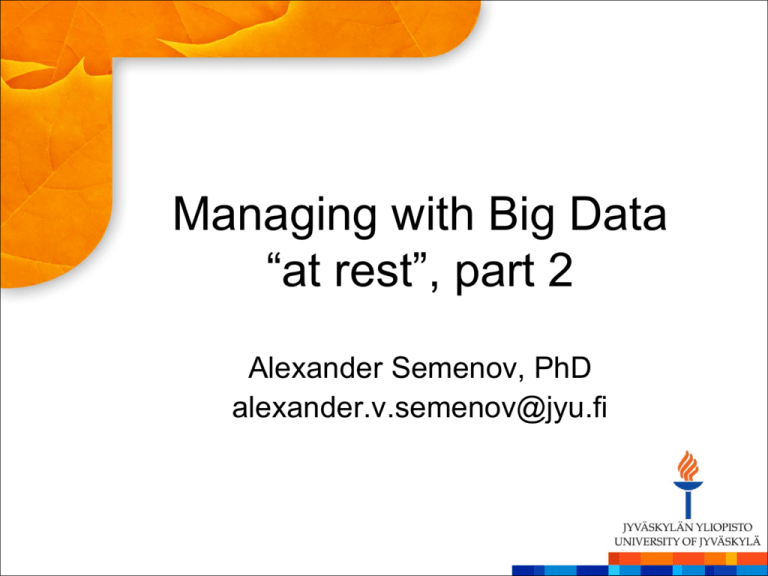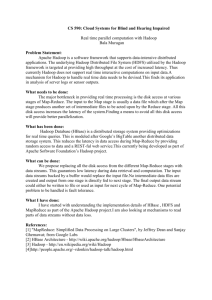slides
advertisement

Managing with Big Data
“at rest”, part 2
Alexander Semenov, PhD
alexander.v.semenov@jyu.fi
ToC
11.11.2015:
MongoDB, CouchDB
Parallel computing introduction
MapReduce introduction
Hadoop
12.11.2015
HDFS, HBase, PIG, Hive
Apache Spark
Stream processing
Apace Storm
MongoDB
cross-platform document-oriented database
– Stores “documents”, data structures composed of field
and value pairs
From http://www.mongodb.org/
– Key features: high performance, high availability,
automatic scaling, supports server-side JavaScript
execution
Has interfaces for many programming languages
https://www.mongodb.org/
MongoDB
> use mongotest
switched to db mongotest
>
> j = { name : "mongo" }
{ "name" : "mongo" }
>j
{ "name" : "mongo" }
> db.testData.insert( j )
WriteResult({ "nInserted" : 1 })
>
> db.testData.find();
{ "_id" : ObjectId("546d16f014c7cc427d660a7a"), "name" : "mongo" }
>
>
>k={x:3}
{ "x" : 3 }
> show collections
system.indexes
testData
> db.testData.findOne()
MongoDB
> db.testData.find( { x : 18 } )
> db.testData.find( { x : 3 } )
> db.testData.find( { x : 3 } )
> db.testData.find( )
{ "_id" : ObjectId("546d16f014c7cc427d660a7a"), "name" : "mongo" }
>
> db.testData.insert( k )
WriteResult({ "nInserted" : 1 })
> db.testData.find( { x : 3 } )
{ "_id" : ObjectId("546d174714c7cc427d660a7b"), "x" : 3 }
>
> var c = db.testData.find( { x : 3 } )
>c
{ "_id" : ObjectId("546d174714c7cc427d660a7b"), "x" : 3 }
MongoDB
db.testData.find().limit(3)
db.testData.find( { x : {$gt:2} } )
> for(var i = 0; i < 100; i++){db.testData.insert({"x":i});}
WriteResult({ "nInserted" : 1 })
> db.testData.find( { x : {$gt:2} } )
{ "_id" : ObjectId("546d174714c7cc427d660a7b"), "x" : 3 }
{ "_id" : ObjectId("546d191514c7cc427d660a7f"), "x" : 3 }
{ "_id" : ObjectId("546d191514c7cc427d660a80"), "x" : 4 }
{ "_id" : ObjectId("546d191514c7cc427d660a81"), "x" : 5 }
{ "_id" : ObjectId("546d191514c7cc427d660a82"), "x" : 6 }
> db.testData.ensureIndex( { x: 1 } )
MongoDB vs SQL
https://docs.mongodb.org/manual/reference/s
ql-comparison/
Example: CouchDB, http://couchdb.org
Open source document-oriented database written
mostly in the Erlang programming language
Development started in 2005
In February 2008, it became an Apache Incubator
project and the license was changed to the
Apache License rather than the GPL
Stores collection of JSON documents
Provides RESTFul API
Query ability is allowed via views:
– Map and reduce functions
Example: CouchDB
When a view is queried, CouchDB takes the
code of view and runs it on every document
from the DB
View produces view result
Map function:
– Written in JavaScript
– Has single parameter – document
– Can refer to document’s fields
curl -X PUT
http://127.0.0.1:5984/albums/6e1295ed6c29495e54cc05947f18c8af -d
'{"title":"There is Nothing Left to Lose","artist":"Foo Fighters"}'
Example: CouchDB
"_id":"biking",
"_rev":"AE19EBC7654",
"title":"Biking",
"body":"My biggest hobby is mountainbiking. The other day...",
"date":"2009/01/30 18:04:11"
}
{
"_id":"bought-a-cat",
"_rev":"4A3BBEE711",
"title":"Bought a Cat",
"body":"I went to the the pet store earlier and brought home a little kitty...",
"date":"2009/02/17 21:13:39"
} { "_id":"hello-world", "_rev":"43FBA4E7AB", "title":"Hello World", "body":"Well
hello and welcome to my new blog...", "date":"2009/01/15 15:52:20" }
CouchDB: Example
View, Map function:
– function(doc) { if(doc.date && doc.title) {
emit(doc.date, doc.title); } }
CouchDB: Example
Map result is stored in B-tree
Reduce function operate on the sorted rows
emitted by map function
Reduce function is applied to every leaf of Btree
– function(keys, values, reduce) { return
sum(values); }
CouchDB vs SQL
http://guide.couchdb.org/draft/cookbook.html
Conclusions
PostgreSQL: Fixed schema, SQL query
language. Database has different tables with
data
MongoDB: stores JSON data, database has
different collections, which store JSON
documents
CouchDB: stores JSON data, database
contains documents; view functions define the
queries
Parallel computing
With horizontal scaling (scaling out) the processing is
carried out on several computers same time
Parallel computing is a form of computation in which
many calculations are carried out simultaneously
– Large problems may be decomposed into smaller ones
Parallel computer programs are more difficult to write
than sequential ones
– Some algorithms can not be parallelized
– Synchronization should be taken into account
– increasing the degree of parallelization also increases
communication costs
Parallel computing
Bit level parallelism
– Increasing processor word size, which reduces number of
instructions that processor should perform in order to process
variables that did not fit into a “word” earlier: 8 bit, 16 bit, 32
bit, 64 bit
Instruction level parallelism
– Several instructions may execute on one processor in parallel
(if they are not dependent on each other)
– Performed inside the processor
• Example: sum and multiplications operations
a = x*y
b=j+k
Parallel computing
Data parallelism
– Each processor performs same task on different parts
of the data
data = [1,2,3,4];
if (proc == 1) {
process(data[0:2]);
} else if (proc == 2) {
process(data[2:4]);
}
Task parallelism
– Each processor executes its own task
Parallel computing vs Distributed
computing
Parallel computing:
– Typically, all processors or cores have access to
the same shared memory
• Multi core, symmetric multiprocessing
Distributed computing:
– Each processor has its own memory
– Interconnected by a network
– Communication costs are much higher, involves
coordination
20
Speedup
Speedup measures increase in running time
due to parallelism.
Based on running times, S(n) = ts/tp , where
–
–
–
n denotes number of CPUs
ts is the execution time on a single processor, using
the fastest known sequential algorithm
tp is the execution time using a parallel processor.
For theoretical analysis, S(n) = ts/tp where
–
–
ts is the worst case running time for of the fastest
known sequential algorithm for the problem
tp is the worst case running time of the parallel
algorithm using n PEs.
Speedup
Sequential execution time
Speedup
Parallel execution time
Maximum speedup is equal to n (number of CPU)
– Superlinear speedup is also possible
• Parallel system may have extra memory
Usually, the best speedup possible for most applications is
much smaller than n
– Usually some parts of programs are sequential and allow only
one CPU to be active.
– Sometimes a large number of processors are idle for certain
portions of the program.
• During parts of the execution, many CPUs may be waiting to
receive or to send data.
• E.g., blocking can occur in message passing
Speedup
Speedup
ideal
Super-linear
Saturation
Disaster
Number of processors
Amdahl's law
The speedup of a program using multiple
processors in parallel computing is limited by
the time needed for the sequential fraction of
the program
Let f be the fraction of operations in a computation that must be
performed sequentially, where 0 ≤ f ≤ 1. The maximum speedup
achievable by a parallel computer with n processors is
1
1
S ( n)
f (1 f ) / n f
Amdahl's law
Amdahl's Law approximately suggests:
– “Suppose a car is traveling between two cities 60
miles apart, and has already spent one hour
traveling half the distance at 30 mph. No matter
how fast you drive the last half, it is impossible to
achieve 90 mph average before reaching the
second city. Since it has already taken you 1 hour
and you only have a distance of 60 miles total;
going infinitely fast you would only achieve 60
mph.”
25
Example 1
50% of a program’s have to be executed
sequentially. What is the maximum possible
speedup?
S ( n)
1
0.5
S ( n) 2
Basic idea: when n -> infinity, 50% will still be sequential,
while remaining 50% (parallel part) would be executed in time -> 0
Thus, it will be twice faster
26
Example 2
95% of a program’s execution time occurs
inside a loop that can be executed in parallel.
What is the maximum speedup we should
expect from a parallel version of the program
executing on 8 CPUs?
1
S (8)
5.9
0.05 (1 0.05) / 8
Parallelizability
Inherently serial problems are those problems
which can not be parallelized
– Computations depend on each other
Embarrassingly parallel problems can be
easily decomposed into parallel tasks
– No communication is required between the parts
Example: OpenMP
Open Multi-Processing
Library, that adds multiprocessing support to
C, C++, and Fortran
http://openmp.org/
C++ version:
– Offers sets of preprocessor directives
– Program should be compiled with OpenMP support
OpenMP
int main(int argc, char *argv[]) {
const int N = 100000;
int i, a[N];
#pragma omp parallel for
for (i = 0; i < N; i++)
a[i] = 2 * i;
return 0;
}
OpenMP
#include <iostream>
using namespace std;
int main()
{
#pragma omp parallel
{
cout<<"Hello"<<endl;
}
return 0;
}
Synchronization
When parallel program is being developed,
typically programmer should care about
synchronization
– Otherwise the same data may be rewritten by
parallel sections, etc
There are many mechanisms
–
–
–
–
Locks
Critical sections
Mutexes
etc
OpenMP
#include <iostream>
using namespace std;
int main()
{
#pragma omp parallel
{
#pragma omp critical
cout<<"Hello"<<endl;
}
return 0;
}
MapReduce
MapReduce is a programming model and an
associated implementation for processing and
generating large data sets (From Jeffrey Dean and
Sanjay Ghemawat, 2004)
Inspired by the map and reduce primitives present in
functional languages
– map and fold
MapReduce was developed by Google, described in a
paper “MapReduce: Simplified Data Processing on
Large Clusters”
Allows programmers without any experience with
parallel and distributed systems to easily utilize the
resources of a large distributed system
Map and fold
map takes a function f and applies it to every
element in a list
– Map takes single argument
fold iteratively applies a function g to
aggregate results
– Fold takes two arguments (first one may be 0), the
second is a list
Sum of squares x^2 + y^2 + … + z^2
– Map takes one parameter and squares it
– Fold gets the list iteratively sums them up
Map and Fold
http://lintool.github.io/MapReduceAlgorithm
s/index.html
MapReduce
Users specify a map and a reduce functions
map function processes a key/value pair to
generate a set of intermediate key/value pairs
Shuffle and sort step:
– Groups data by key, orders the values
reduce function merges all intermediate values
associated with the same intermediate key
– Values are in sorted order
programs written in this style are automatically
parallelized and executed by a run time system
MapReduce
The run-time system handles
– partitioning the input data
– scheduling the program's execution across a set of
machines
– handling machine failures
– managing the required inter-machine
communication.
There are many implementations, one of the
most popular is Apache Hadoop
MapReduce example
function map(String name, String document):
// name: document name
// document: document contents
for each word w in document:
emit (w, 1)
function reduce(String word, Iterator partialCounts):
// word: a word
// partialCounts: a list of aggregated partial counts
sum = 0
for each pc in partialCounts:
sum += ParseInt(pc)
emit (word, sum)
MapReduce example 1, word count
Input: Hello World Bye World
Hello Hadoop Goodbye Hadoop
map:
< Hello, 1>
< World, 1>
< Bye, 1>
< World, 1>
< Hello, 1>
< Hadoop, 1>
< Goodbye, 1>
< Hadoop, 1>
Shuffle:
<Hello, [1,1]> <World, [1, 1]> <Bye, [1]> <Hadoop, [1,1]> <Goodbye, [1]>
Reduce:
< Bye, 1>
< Goodbye, 1>
< Hadoop, 2>
< Hello, 2>
< World, 2>
MapReduce, example 2
http://lintool.github.io/MapReduceAlgorithm
s/index.html
(From Jeffrey Dean and Sanjay
Ghemawat, 2004)
Combiners
Word count emits a key-value pair for each word in the collection
– all these key-value pairs need to be copied across the network
– the amount of intermediate data will be larger than the input collection itself
Solution is to perform local aggregation on the output of each mapper
– to compute a local count for a word over all the documents processed by the
mapper
Combiner is an optimization in MapReduce that allows for local
aggregation before the shuffle and sort phase
– Might be viewed as “mini-reducer”
– Reducer may be used as a combiner only if it is associative and
commutative
– In word count example reducer can be used as a combiner due to
associativity and commutativity:
• A+B+C = A + (B+C)
• A+B = B + A
Partitioners
Partitioners are responsible for dividing up the
intermediate key space and assigning
intermediate key-value pairs to reducers
May help to handle imbalance in the amount
of data associated with each key
– So that each reducer would have equal number of
keys
Combiners
http://lintool.github.io/MapReduceAlgorithm
s/MapReduce-book-final.pdf
Combiner example
basic MapReduce algorithm that computes the mean of values
associated with the same key
1) MapReduce for mean computation (without combiner)
From http://lintool.github.io/MapReduceAlgorithms/index.html
Combiner example
In mean computation, reducer cannot be used
as a combiner, since
From http://lintool.github.io/MapReduceAlgorithms/index.html
MapReduce applications
Count of URL Access Frequency: The map
function processes logs of web page requests
and outputs <URL, 1>. The reduce function adds
together all values for the same URL and emits a
<URL, total count> pair.
ReverseWeb-Link Graph: The map function
outputs <target, source> pairs for each link to a
target URL found in a page named source. The
reduce function concatenates the list of all source
URLs associated with a given target URL and
emits the pair: <target, list(source)>
Speculative execution
An optimization that is implemented by both Hadoop
and Google’s MapReduce implementation
Idea:
– the map phase of a job is only as fast as the slowest map
task
– Similarly, the completion time of a job is bounded by the
running time of the slowest reduce task
– with speculative execution, an identical copy of the same task
is executed on a different machine, and the framework simply
uses the result of the first task attempt to finish
– Improves the results by 44% (Jeffrey Dean and Sanjay
Ghemawat. MapReduce: Simplified data processing on large
clusters, 2004)
MapReduce cluster
Machines are typically dual-processor x86 processors
running Linux, with 2-4 GB of memory per machine.
Commodity networking hardware is used. –typically either
100 megabits/second or 1 gigabit/second
A cluster consists of hundreds or thousands of machines,
and therefore machine failures are common.
Storage is provided by inexpensive IDE disks attached
directly to individual machines. A distributed file system
developed in-house is used to manage the data stored on
these disks
Users submit jobs to a scheduling system.
(From Jeffrey Dean and Sanjay Ghemawat, 2004)
MapReduce
Data locality is important: map tasks should
use data available on the present node
For some tasks partitioning is important
One of the refinements is combiner function:
reduce function applied after map at each
cluster
Data joins
SELECT * FROM employee JOIN
department ON employee.DepartmentID =
department.DepartmentID;
Data joins
Join may be implemented in MapReduce
Idea:
– we map over both datasets and emit the join key
as the intermediate key, and the tuple itself as the
intermediate value
– all tuples will be grouped by the join key
– This is called reduce-side join
MapReduce algorithms
many algorithms cannot be easily expressed
as a single MapReduce job
complex algorithms may be decomposed into
a sequence of jobs
– output of one job becomes the input to the next
– repeated execution until some convergence criteria
MapReduce implementations
Google MapReduce
Apache Hadoop
CouchDB
targeted specifically for multi-core processors
for GPGPUs (He et al., Mars: A MapReduce
framework on graphics processors,2008)
And many others
Apache Hadoop
Open-source software framework for distributed storage
and distributed processing of Big Data on clusters of
commodity hardware
Was created in 2005, developed in Java
http://Hadoop.apache.org
Consists of:
– Hadoop Common: The common utilities that support the other
Hadoop modules.
– Hadoop Distributed File System (HDFS™): A distributed file
system that provides high-throughput access to application data.
– Hadoop YARN: A framework for job scheduling and cluster
resource management.
– Hadoop MapReduce: A YARN-based system for parallel
processing of large data sets.
Prominent users
EBay
– 532 nodes cluster (8 * 532 cores, 5.3PB).
Facebook
– Apache Hadoop is used to store copies of internal log
and dimension data sources and use it as a source for
reporting/analytics and machine learning.
– 2 major clusters:
• A 1100-machine cluster with 8800 cores and about
12 PB raw storage.
• A 300-machine cluster with 2400 cores and about 3
PB raw storage.
• Each (commodity) node has 8 cores and 12 TB of
storage.
http://wiki.apache.org/hadoop/PoweredBy
Prominent users
Last.fm
– 100 nodes
– Dual quad-core Xeon L5520 @ 2.27GHz & L5630 @
2.13GHz , 24GB RAM, 8TB(4x2TB)/node storage.
– Used for charts calculation, royalty reporting, log analysis,
A/B testing, dataset merging
LinkedIn
– ~800 Westmere-based HP SL 170x, with 2x4 cores, 24GB
RAM, 6x2TB SATA
– ~1900 Westmere-based SuperMicro X8DTT-H, with 2x6
cores, 24GB RAM, 6x2TB SATA
– ~1400 Sandy Bridge-based SuperMicro with 2x6 cores,
32GB RAM, 6x2TB SATA
http://wiki.apache.org/hadoop/PoweredBy
Hadoop cluster
Hadoop cluster includes a single master and
multiple worker nodes.
The master node consists of a JobTracker,
TaskTracker, NameNode and DataNode
– May be replicated
A slave or worker node acts as both a
DataNode and TaskTracker
Data are placed in HDFS filesystem
Hadoop cluster
Clients submit jobs to JobTracker
JobTracker submits it to available
TaskTracker nodes in the cluster
JobTracker knows which node contains the
data, and which other machines are nearby
– Reduces network traffic because of rack
awareness
From http://lintool.github.io/MapReduceAlgorithms/index.html
HDFS
HDFS, The Hadoop Distributed File System
– distributed file system designed to run on commodity
hardware
– HDFS is highly fault-tolerant
– HDFS provides high throughput access to application
data and is suitable for applications that have large data
sets
– Data in HDFS are automatically replicated
– Metadata are stored in Namenode
– Data are stored in Datanode
– HDFS is not optimized for low-latency data access
HDFS
Each map task is assigned a sequence of
input key-value pairs, called an input split in
Hadoop.
Input splits are computed automatically and
the execution framework strives to align them
to HDFS block boundaries so that each map
task is associated with a single data block.
http://hadoop.apache.org/docs/r1.2.1/hdfs_
design.html
HBase
HBase is a column-oriented database
Runs on top of HDFS
Features
– Linear and modular scalability.
– Strictly consistent reads and writes.
– Automatic and configurable sharding of tables
HBase data model
HBase organizes data into tables
– Resembles SQL, but has different data model!
Row: Within a table, data is stored according to its row
– Rows are identified uniquely by their row key
Column Family: Data within a row is grouped by column family.
– Column families also impact the physical arrangement of data stored in
HBase
Column Qualifier: Data within a column family is addressed via
its column qualifier, or simply, column
Cell: A combination of row key, column family, and column
qualifier uniquely identifies a cell
– Values within a cell are versioned
Primary Functions: get, put, scan
Amandeep Khurana, Introduction to HBase Schema Design,
http://0b4af6cdc2f0c5998459c0245c5c937c5dedcca3f1764ecc9b2f.r43.cf2.rackcdn.com/9353login1210_khurana.pdf
HBase row
HBase row
Amandeep Khurana, Introduction to HBase Schema Design,
http://0b4af6cdc2f0c5998459c0245c5c937c5dedcca3f1764ecc9b2f.r43.cf2.rackcdn.com/9353login1210_khurana.pdf
Apache Hive
Apache Hive is a data warehouse infrastructure built
on top of Hadoop for providing data summarization,
query, and analysis
– Was originally developed by Facebook
– supports analysis of large datasets stored in Hadoop's HDFS
HiveQL query language: based on SQL-92 standard
but does not fully supports it
A compiler translates HiveQL statements into a
directed acyclic graph of MapReduce jobs, which are
submitted to Hadoop for execution
Hive should be used for batch processing, not the real
time tasks!
HiveQL example
1)
CREATE TABLE a (k1 string, v1 string);
CREATE TABLE b (k2 string, v2 string);
SELECT k1, v1, k2, v2
FROM a JOIN b ON k1 = k2;
2)
SELECT a.* FROM a JOIN b ON (a.id = b.id
AND a.department = b.department)
Apache Pig
Pig raises the level of abstraction for
processing large datasets
Pig was originally developed by yahoo
Pig consists of:
– The language used to express data flows, called
Pig Latin.
– The execution environment to run Pig Latin
programs.
Pig turns the transformations into a series of
MapReduce jobs
Apache Pig
-- max_temp.pig: Finds the maximum temperature by
year
records = LOAD 'input/ncdc/micro-tab/sample.txt'
AS (year:chararray, temperature:int,
quality:int);
filtered_records = FILTER records BY temperature
!= 9999 AND
(quality == 0 OR quality == 1 OR quality == 4 OR
quality == 5 OR quality == 9);
grouped_records = GROUP filtered_records BY year;
max_temp = FOREACH grouped_records GENERATE group,
MAX(filtered_records.temperature);
DUMP max_temp;
Apache Pig
DESCRIBE records;
>> records: {year: chararray,temperature:
int,quality: int}
DUMP grouped_records;
>> (1949,{(1949,111,1),(1949,78,1)})
(1950,{(1950,0,1),(1950,22,1),(1950,-11,1)})
DESCRIBE grouped_records;
>> grouped_records: {group:
chararray,filtered_records: {year: chararray,
temperature: int,quality: int}}
Apache Pig
input_lines = LOAD '/tmp/my-copy-of-all-pages-on-internet' AS
(line:chararray);
-- Extract words from each line and put them into a pig bag
-- datatype, then flatten the bag to get one word on each row
words = FOREACH input_lines GENERATE FLATTEN(TOKENIZE(line)) AS
word;
-- filter out any words that are just white spaces
filtered_words = FILTER words BY word MATCHES '\\w+';
-- create a group for each word
word_groups = GROUP filtered_words BY word;
-- count the entries in each group
word_count = FOREACH word_groups GENERATE COUNT(filtered_words) AS
count, group AS word;
-- order the records by count
ordered_word_count = ORDER word_count BY count DESC;
STORE ordered_word_count INTO '/tmp/number-of-words-on-internet';
Apache Spark
Is a cluster computing platform designed to be
fast and general purpose
– extends the popular MapReduce model
Developed in the University of California,
Berkeley
– Development started in 2004
– In 2013 the project was donated to Apache Software
Foundation
http://spark.apache.org/
Book: Holden Karau, Andy Konwinski, Patrick
Wendell & Matei Zaharia, Learning Spark, 2015
Apache Spark, key features
Run programs up to 100x faster than Hadoop
MapReduce in memory, or 10x faster on disk.
Write applications quickly in Java, Scala,
Python, R.
– Contains API and shell
Combine SQL, streaming, and complex
analytics.
Contains libraries, e.g. machine learning and
graph processing
Spark architecture
From Holden Karau, Andy Konwinski, Patrick Wendell & Matei
Zaharia, Learning Spark, 2015
Examples
Python shell, word count
Scala shell, word count
From Holden Karau, Andy Konwinski,
Patrick Wendell & Matei Zaharia, Learning
Spark, 2015
Core concepts
Primary abstraction is Resilient Distributed
Dataset (RDD)
– Can be initialized with data, e.g. from CSV file, from
database, etc
– Later, different operations can be applied to RDD.
RDD operations
– Transformations: return new RDD
– Actions: operations that return a final value to the driver
program or write data to an external storage system
Spark’s RDDs are by default recomputed each
time you run an action on them
– RDD.persist() can be used to keep RDD in memory
Example: union transformation
Persisting RDD in memory
From Holden Karau, Andy Konwinski, Patrick Wendell & Matei Zaharia,
Learning Spark, 2015
Example: filter transformation
From Holden Karau, Andy Konwinski, Patrick Wendell & Matei Zaharia,
Learning Spark, 2015
Common RDD operations
map – applies function to all RDD elements
filter - returns only those elements which
adhere to filter
Set operations: union, subtract, distinct,
intersection
From Holden Karau, Andy Konwinski, Patrick Wendell & Matei Zaharia, Learning Spark, 2015
Common RDD operations
reduce
– takes a function that operates on two elements of
the type in your RDD and returns a new element of
the same type
– sum = rdd.reduce(lambda x, y: x + y)
Aggregate
take(n) – returns subset of n elements of RDD
collect – returns all RDD elements
count, countByValue
Key-Value pairs operations
reduceByKey(func)
– Combines values with the same key
groupByKey()
– Group values with the same key.
keys()
– Return an RDD of just the keys.
Join operations:
– Inner join, rightOuterJoin, leftOuterJoin
Stream processing
Stream processing is designed to analyze and act
on real-time streaming data, using “continuous
queries”
– i.e. SQL-type queries that operate over time and buffer
windows.
“Big Data” vs “Fast Data”
Essential to stream processing is streaming
analytics, or the ability to continuously calculate
mathematical or statistical analytics on the fly
within the stream
Often, sampling and approximate algorithms are
applied
Stream examples
Network of sensors
– Assume one sensor generates 4 bytes of data per
0.1 second (for example temperature)
– 3.5 MB per day
– Then, 1 million of sensors would produce 3.5 TB
per day
– Query examples: maximum temperature, average
temperature
Web traffic
– User search queries
Stream processing
Whole dataset can not be stored and
accessed fast
Standing queries: permanently executing
queries
– E.g. Maximum temperature
Ad hoc queries:
– a question asked once about the current state of a
stream or streams
– May use limited working storage with e.g. time
window of a stream
A data stream management system
From http://infolab.stanford.edu/~ullman/mmds/book.pdf
Stream processing examples
Algorithmic trading
– 300 securities firms and hedge funds that specialize in
this type of trading took in a maximum of US$21 billion
in profits in 2008
– In the U.S., high-frequency trading (HFT) firms
represent 2% of the approximately 20,000 firms
operating today, but account for 73% of all equity
trading volume
– computers that execute trades within microseconds, or
"with extremely low latency"
– light 3.3 milliseconds per 1,000 kilometers of optical
fiber
– Book: Flash boys, Michael Lewis, 2014
Apache Storm
Hadoop was designed for batch processing,
not for the realtime
Apache Storm is an open source framework
that provides massively scalable event
collection.
– was created by Twitter
– https://storm.apache.org/
Implemented in Java and Closure
Apache Storm
Broad set of use cases
– Storm can be used for processing messages and updating databases (stream
processing), doing a continuous query on data streams and streaming the results
into clients (continuous computation), parallelizing an intense query like a search
query on the fly (distributed RPC), and more. Storm's small set of primitives
satisfy a stunning number of use cases.
Scalable
– scales to massive numbers of messages per second. To scale a topology, all you
have to do is add machines and increase the parallelism settings of the topology.
As an example of Storm's scale, one of Storm's initial applications processed
1,000,000 messages per second on a 10 node cluster, including hundreds of
database calls per second as part of the topology. Storm's usage of Zookeeper for
cluster coordination makes it scale to much larger cluster sizes.
Guarantees no data loss
– A realtime system must have strong guarantees about data being successfully
processed. A system that drops data has a very limited set of use cases. Storm
guarantees that every message will be processed, and this is in direct contrast
with other systems .
Apache Storm
Extremely robust
– Unlike systems like Hadoop, which are notorious for being
difficult to manage, Storm clusters just work. It is an explicit goal
of the Storm project to make the user experience of managing
Storm clusters as painless as possible.
Fault-tolerant
– If there are faults during execution of your computation, Storm
will reassign tasks as necessary. Storm makes sure that a
computation can run forever (or until you kill the computation).
Programming language agnostic
– Robust and scalable realtime processing shouldn't be limited to
a single platform. Storm topologies and processing components
can be defined in any language, making Storm accessible to
nearly anyone.
Apache Storm
A stream is an unbounded sequence of tuples
Basic primitives are are "spouts" and "bolts“
– Spouts and bolts have interfaces that programmer
implements to run application-specific logic.
• A spout may connect to the Twitter API and emit a stream
of tweets
• A bolt consumes any number of input streams, does
some processing, and possibly emits new streams.
• Complex stream transformations, like computing a stream
of trending topics from a stream of tweets, require multiple
steps and thus multiple bolts
Spouts and bolts are connected in topology
– Topology is directed acyclic graph
From http://storm.apache.org/tutorial.html
From http://www.slideshare.net/miguno/apache-storm-09-basic-trainingverisign
Thank You!






